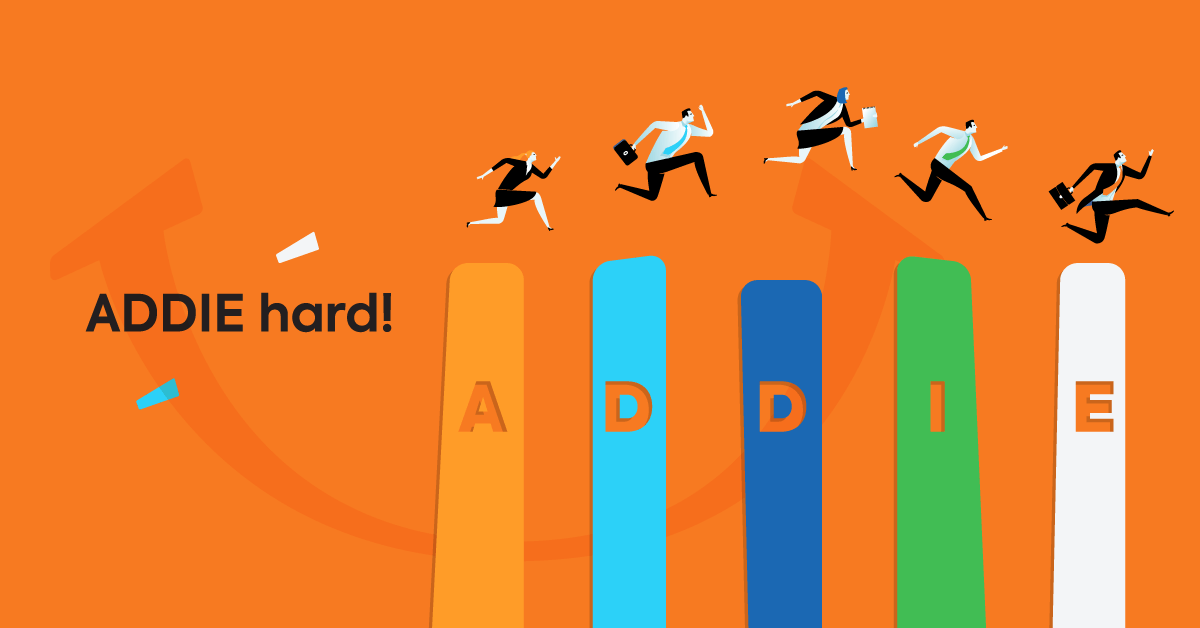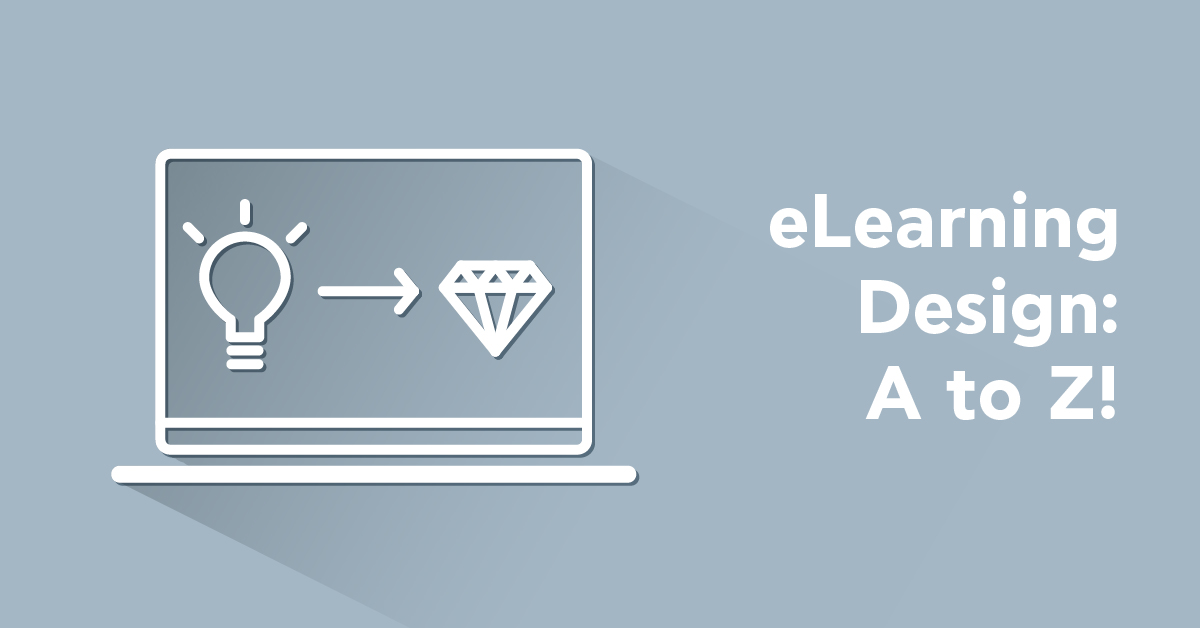It’s is true that the learning universe comes with a bunch of terms. The ADDIE training model, however, is one of the essentials.
The ADDIE model of instructional design is used by experienced instructional designers as part of their online, offline, or even blended learning sessions. Simply put, ADDIE stands for five simple steps: Analysis, design, development, implementation, and evaluation.
But to fully understand what it is and how you can use it in eLearning, you’ll first need to understand what instructional design models are.
So, here’s what you’ll learn today:
- What are instructional design models?
- What is the ADDIE training model?
- The 5 stages of the ADDIE training model
- The advantages and disadvantage(s) of the ADDIE model
What are instructional design models?
Instructional design models exist to provide guidelines and frameworks, so designers can build their training routines carefully.
An instructional design model is based on pedagogical scenarios. Their purpose is to help instructors achieve training goals, so trainees can acquire knowledge and then retain it. So, when instructional designers need to determine the exact steps of their training procedure, they turn to instructional design models.
Currently, there are more than twenty-five commonly accepted prescriptive instructional design methodologies. The most common ones include:
- ADDIE
- Dick and Carey
- Assure
- The Kirkpatrick Model
- Gerlach-Ely Model
- TPACK and more
What do they all have in common?
All instructional design models come with the elements that Branch and Merrill (2002) explained all instructional design models should consist of:
- Clear, well-defined goals.
- Outcomes that are measurable, reliable, and valid.
- Data that are the heart of the whole process, so designers should keep it empirical.
- A team effort during designing.
- Real-life behaviors from learners, applicable to real-world problems.
And the ADDIE training model meets all these requirements. Let’s look at ADDIE more closely now:
Definition of the ADDIE training model
So, what does “ADDIE” mean?
Basically, “ADDIE” comes from a simple acronym. As a 5 step training model, its name refers to the 5 different stages of creating a course:
- Analysis
- Design
- Development
- Implementation
- Evaluation
The reason the model is called ADDIE is that every step should be taken in that exact order. However, the ADDIE model follows a circular pattern that repeats itself until trainees reach perfection. Also, due to the last stage of the ADDIE learning model (evaluation), you get all the feedback you need so you can keep on improving both your skills and your learners’ experience.
In general, when we’re talking about the overall ADDIE process, we’re not referring to an instructional design model per se. It’s, most of the time, the primary process most instructional designers choose to create courses and learning material. In other words, if the rest of the models were competitive distance runners, ADDIE would be the stadium.
This is precisely why more sophisticated users prefer to call ADDIE an Instructional Systems Design (ISD) model, because the majority of the existing instructional design models are based on it.

The 5 stages of the ADDIE training model
To fully specify how an instructor can benefit from the ADDIE model, we need to take a look at the five key stages it consists of individually. So, if you’re interested in the application of the ADDIE model, we strongly suggest that you keep reading for more info:
1. A is for Analysis
In the beginning, there was research — it all starts with it, after all, doesn’t it?
So, the first thing you want to do is analyze the current training ground, and see your trainees’ knowledge gaps, their past training, what’s worked, what hasn’t, and so on. This is actually among the most essential phases of the training process.
You may even ask yourself about the purpose of your training. So, except for the current situation, you need to look into your goals and expectations from your program, as well as the media and methodologies you’re going to use.
Sounds intimidating? Don’t worry! Here’s a tip for you: Use the method that the journalistic community lives by.
When reporters want to write a story, they ask themselves six questions that they must address as soon as their article starts (lede). This is the “5 W’s and an H” rule.
- Who is going to receive your training? (Analyze your trainees)
- What will your training be about? (The context of your training)
- When is it going to happen? (Set a time-frame right off the bat)
- Where is it going to happen? (Will you deliver it online or in a classroom?)
- Why are you doing this? (The objectives of your training)
- How are you going to achieve this? (The methodology and the requirements)
If you have a clear answer to each one of these questions as well as a general analysis of the current situation, then you have completed both your plan and the very first step.
2. D is for Design
You know what the first step in the ADDIE training process is. Now it’s time to turn theory (Analysis) into action (Design).
The very first thing you want to do is to decide what format you are going to be using. Is it going to be an interactive training course, a microlearning course, or a video course? The ADDIE model is great for creating courses but you are the one who needs to determine what type of course it’s going to be.
Second, figure out the methodology and the strategy of your training delivery. In what order are you going to feature each section of your training? Are you going to brief your trainees first (preliminary training) to motivate them? How much time are they going to need to complete your course? These may sound like simple questions, but they need answers before you start creating your prototype.
After that, you have to make sure your course is ready to go. Don’t unleash it into the wild just yet. Test it with members of your team to see whether you need to make any small (or even significant) adjustments, and conclude the final product overview.
3. Another D for Development
Develop to engage: this should be your third-step mantra.
The step of Development in the ADDIE training model is nothing more than putting all the ideas and the core creative designs you’ve thoughtfully planned into action. All the decisions you’ve taken during the Design stage are now going to work as guides for the Development phase.
Polish the details by adding graphs, colors, graphics, multimedia, etc. Some people might feel like they’re shifting the deckchairs on the Titanic (I see you, you technical junkies!) but the level of learner engagement will increase. Dramatically.
The Development phase will need a lot of testing. Create your course and start testing it so you can check for grammatical, syntax, or spelling errors and, if using an online learning platform, that there are no bugs in modules, navigation, etc.
One last thing you might want to check is your content. Is it too long? Maybe too short to include all the information in a comprehensible way perspicuously? What about the flow and the pacing? Does it grab your trainees’ attention?
4. I stands for Implementation
Now that you’ve finished your research, designs, and testing it’s high time you shared your course with the world. Implementation is always one of the most important training process steps. But look how the ADDIE training process steps are connected:
- The stage of Analysis determines the very nature of your course.
- In the Design phase, you determine how your whole lesson unfolds.
- During Development, you put everything into action and test it.
- Now, in Implementation, real learners get to experience your course first-hand.
If you’re wondering how to implement a training program, an LMS is the answer.
An efficient LMS (Learning Management System) software will help you both share your course with your learners and monitor how it performs. Do you need to see how many users have signed up for your courses? Those who’ve passed or failed? Great! An LMS sounds like a perfect solution for you.
Deliver successful training that you can actually track and measure!
TalentLMS is an award-winning system equipped with all the up-to-date monitoring tools.
But just a heads-up — a serious one: When you are choosing an LMS, you need to make sure the reporting tools are really on-point so you can monitor your learners’ performance and progress. And monitoring is essential in ADDIE because this is what the final step is all about:
5. Finally, E for Evaluation
The moment you’ve all been waiting for. The time to answer the “what is the final step in the ADDIE training process” question.
Don’t believe, even for a second, that when we’re talking about evaluation, we’re talking about you evaluating learners. You are being assessed, too! This is the power of ADDIE. That you can actually monitor results, improve yourself, and become a better instructional designer. And if you find out that something’s not right, you can just revise it.
A quick fix to see how good or bad your course performed is to ask your very own learners.
Add a post-training evaluation survey to the end of your course and ask them about their experience. What did they lean? Do they have any suggestions? Identify any gaps you need to fill and address them right away, either in this specific course or in future ones.
The benefits of the ADDIE training model (and ONE disadvantage)
We know that presenting the benefits for a model that’s universally accepted feels like trying to convince you of the truth.
But, in case you’re brand new to instructional design, here’s a brief list of the advantages of the ADDIE instructional design model:
- First, with ADDIE you never get lost. The structure is so on-point that instructors know what action they need to take before they move to another one.
- It’s great for online, offline, and blended learning.
- Trainers can assess objectives and results to figure out what part of the course needs further attention.
- In an industry full of technicality, ADDIE puts design where it belongs (aka. into the core creation process) to engage more and more learners.
- It’s the Father of all instructional design models, so it combines all of them together.
Now, regarding the disadvantage(s), some instructional designers are not really fascinated with the idea of this linear approach and the waterfall model ADDIE promotes.
Which is partially correct.
To fully use the ADDIE model, you must be familiar with your course’s objectives on the dot. Truth be told, ADDIE kind of assumes you know all your goals and requirements before you start developing or even experimenting with your content. The reason? You can just move from one stage to another, but you can only go forward in a circular motion. As a result, it’s only when you reach the stage of Evaluation that you are free to jump back to one of the previous steps to revise it.
So, in the Analysis stage, you need to analyze yourself and see if you know what you want your learners and yourself to get from the overall procedure.
Conclusion: ADDIE training model helps you reach your goals
Let’s be realistic. The ADDIE training model is one of the most solid, safest choices if you want to create courses that will both educate and engage your learners.
As one of the longest-lasting models (it first appeared in 1975), it has managed to evolve into a key player when it comes to instructional design. Something that no other model has managed to achieve so far.
| Tags: eLearning Design




